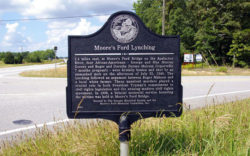In the early 1990s, there was a contest to design the Walton County flag, because counties need flags. Eighth graders all over Walton painted rectangles of cotton and rivers, farmers and numbers. My husband, Ben, was not one of these enthusiastic flag-making eighth graders. He forgot about the contest until right before the judging. He scribbled a design in pencil on a sheet of torn-out spiral notebook paper and turned it in, a burr of paper still clinging to its edge.
He won.
Two years later, Ben played basketball at Loganville High School with a kid—a tall, friendly guy who had an air about him that was different. Part of it was that the kid came and went from the school multiple times a year, because his mom moved a lot. His family life seemed unstable. He’d been gone again from the school for a few weeks already when the news trickled in that, wherever he’d landed, he’d been shot and killed there. He would not be coming back to the team.
• • •
When I was 23, I bought lipstick and vodka. When Ben was 23, he bought 3 acres of land and a century-old millhouse in High Shoals. The house was covered with asbestos siding and linoleum; the 3 acres, with kudzu. Ben took breaks from hacking at the kudzu he’d bought to explore the 5 acres next door. The lot was thickly forested, and webbed by smilax and wisteria vines. There was no path, so Ben used his machete to cut his way through. After a few minutes, he reached the middle of the 5 acres. He could no longer see the cleared edge of his property, or the peak of the roof of his new house.
In the middle of the lot slumped three derelict single-wide trailers. They were caved in at the middle, and skinny trash trees grew up around them, penning them in. Ben wondered how they’d gotten the trailers back here to begin with. There was no road.
He climbed up into one of the trailers, through what used to be the wall of the back bedroom. Clothes moldered alongside stacks of magazines and unopened mail. An alarm clock shaped like a baseball lay in a corner, its cord yellow and peeling. The hall floor had fallen in, so Ben scooted his feet across two struts. The place smelled brown and rotten. In the main room was a volcano of junk: plastic cups, old towels, gnarls of Christmas lights, a coffee maker. Balanced on top of this pile, like it had been put there on purpose, was a photo album.
Ben opened it. The baby on the first page grew up into a good-looking little leaguer, and then a 12-year-old having a birthday, and then into the kid Ben played basketball with at school—the one who moved around a lot and, eventually, they said, got shot. The last picture in the book was his Loganville High School portrait.
Ben closed the photo album and walked back to his house. He took a shower, then went to see his neighbor on the other side—an elder at Ben’s church. He’d grown up around here and had come home to start a study center for Christians and others. Ben had just bought his house to be a part of this community. It was still in the early stages, and no one was sure yet how it would go. High Shoals had been a wild place for so long.
Everyone knew the stories of the man in the big house on the hill who owned the water and most of the town. Everyone knew about the Pontiac and the tow rope, the mica mine, the airstrip, the automatic weapons, the biker gangs, the mayoral campaign, the unruly son, the lawsuits, the portraits featuring him astride a horse and dressed in Confederate uniform, the shootings, the manhunts, the bodies.
Junior, the son of the man in the big house, had once been in prison for manslaughter for shooting somebody at a house two doors down from the one Ben now owned. Everybody knew it—the fact colored the town.
Ben found his neighbor in the abandoned Baptist Church, unpacking books. “I need to ask you,” Ben said. “Who did Junior shoot?”
• • •
Ben had a hard time getting his head around the fact that the lot right next door to him was where his high-school friend had lived, and that right next door to that was the house where he’d died. He went back in the woods to try to figure it out.
“You stealing stuff from my trailers?”
There was a man standing in the forest on the other side of the trailers—a rangy man with lank black hair. Ben had been looking at the trailers and had not seen him standing over there in the bushes.
“No,” said Ben. “I bought the house next door and was just walking around.”
“They’re mine,” said the man, like Ben had argued about it.
“OK,” said Ben. He raised his machete by way of goodbye and walked back the way he’d come.
• • •
There’s a lot of security at the government building in Walton County, because that’s where the courthouse is. The flag my husband designed in eighth grade flies in front of the building, underneath the state and American flags. I pointed at it as we walked in from the parking lot.
“That’s the flag your father designed,” I told the kids, “because he is a true patriot.”
When it was our turn to go through the metal detector, my 4-year-old looked at the guard. “My father designed the American flag,” he told him.
“That so?” said the guard. “Good for him.”
Like what you just read? Support Flagpole by making a donation today. Every dollar you give helps fund our ongoing mission to provide Athens with quality, independent journalism.









